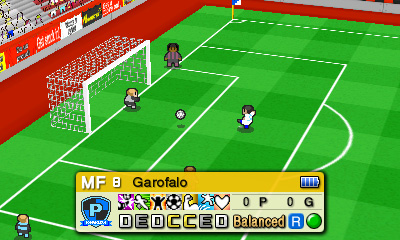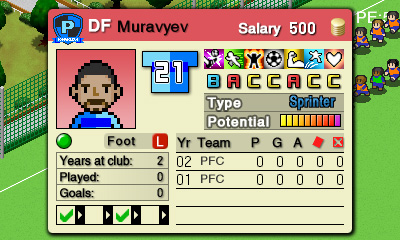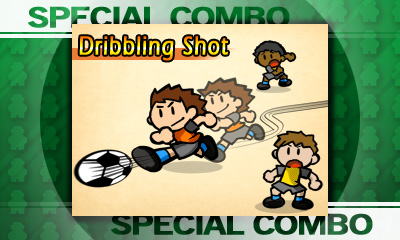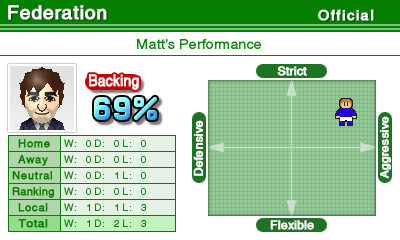
Nintendo Pocket Football Club review
Since my earliest days playing video games, football management simulators have been a constant in my library. The old Championship Manager games on PC hold a dear place in my heart and more than a few hot summers have passed by in a blur of score reports, statistical analysis and squad adjustment. Why go outside and enjoy the warm sun on my back as I play the real thing when I could be sat in my room with curtains drawn, huddled up in an old armchair and surrounded by discarded crisp packets and coke cans as the comforting whir of my aging PC’s fan buzzed in the background. One match would lead to five, then the next thing you know I’ve played through a whole season doing my best to ignore that pain in my bladder that’s been telling me that I needed to pee three hours ago. As technology has advanced, so has the ability for these games to more fully portray the life of a manager and all it entails. No longer is it just about picking your best starting eleven and dabbling in the transfer market. Now, the whole gamut of what the job involves can be duplicated for you to live out your fantasies and attempt to do what David Moyes could not and take Manchester United to glory. However, on a personal level, as the remit of these games has increased, so has my interest in them started to wane. The more these games asked you to do, so came the feeling that I was no longer really enjoying the experience. So, how refreshing then to partake in Nintendo’s latest entry in the genre? Based on an earlier Japan-only GameBoy Advance game, Nintendo Pocket Football Club places you in the shoes of a football manager starting out in the lower leagues. It’s up to you to train your squad and take them to victory. For those well versed in the ways of football management sims, the first thing that is apparent is that the game strips a lot away from what is required of you as the boss – some would argue far too much – and I cannot deny that this will make or break the game for some, but for me it’s such a huge breath of fresh air. Knowing that my attention is focused purely on the team and their development, rather than having to deal with all the surrounding paraphernalia, really does make a huge difference.
Things start off slowly as you’re encouraged to get to know your squad, with lots of practice matches and friendlies to partake in before the first season kicks off. Practice matches allow you to play behind closed doors in order to see how your team is functioning, while friendlies are played in front of the fans. The fans are integral to your continued employment at the club as if you get too many bad results they’ll call for you to be sacked. Conversely, get a string of wins under your belt and the fans will be chanting your name on the terraces. These early games also introduce you to the trading card system that the game employs as part of your team’s training. During each game your Mii (representing you as manager) will pop up to proclaim such pearls of wisdom as “The guys aren’t pressuring enough” or “We’re too slow on the counter-attack” and you’ll earn a corresponding trading card that is banked for later use within the training camp. These cards fall under four categories; Tactical, Technical, Physical and Support. Within these areas you’ll be able to improve your players’ speed, stamina, willpower and so on. During training you can choose any of your players and assign up to three cards to him in order to boost his stats in the corresponding areas, so you may plump to use ‘Jumping’, ‘Exercise’ and ‘Running’ for your goal keeper and see his stats increase accordingly to help improve his game. Combining certain cards will create a combo of sorts so that you can get an even bigger boost to your player stats. It is not essential to do all this as your team will (slowly) improve over time anyway, but it’s a very effective way of bolstering your side as you make your way through pre-season and into the league proper to help give you the edge, as well as ensuring that your players are not all collapsing around you mid-game through a lack of stamina.
As the players’ stats improve, so they will evolve from ‘balanced’ (which is what all your players will begin as) into different styles of play, such as stoppers, explorers or mavericks, and this in turn allows you to play around with your formations to suit the nature of your team. There is a transfer market of sorts for you to dabble in but the list of available players is not very long and the onus here is more on strengthening the squad you currently have rather than spending your way to the title. Sure, it’s all pretty basic when compared to other football management sims but there is still enough here to make you feel involved in the development of your side and not just be a passive observer. Sadly, there is no way to change tactics within each game once it has started unless you make a substitution, and what alterations you can make are limited to your zones of play (determining how far back you want your team to sit in defence, or how far forward you want your attackers to push up), whether you want your approach to the game to be attacking, defensive or just balanced, and identifying three danger men to watch on the opposing side. But here-in lies the rub; the omission of such things is disappointing if you yearn for more direct influence on the game, but to leave it all out helps to retain the game’s singular focus on the development of your squad. Once you’ve done your training, picked your starting eleven and the formation, it then falls to the team to deliver the goods and I for one prefer this; it provides a more realistic approach to the game in general and makes your choices before the game all the more important.
The matches themselves are hugely entertaining and do a wonderful job of imbuing your squad with real character. You get a far more realistic interpretation of the game compared to other, somewhat dry, alternatives in other games and you’ll regularly see balls being hoofed into the upper tiers, possession being given away and shots going whizzing over the bar. It may all look very basic in screenshots but it’s great to watch. Players are animated in a pretty basic fashion but it’s very charming all the same. One thing that may irritate some is that you are not able to fast forward during matches. You have to sit and watch each game in its entirety. At first I thought that having to sit through each and every game in full with no way to speed things up would be annoying but it quickly became clear that not only was the in-game engine able to provide a decent game of football (in all my time playing there hasn’t been one game I’ve got bored of while watching), but actually seeing your team play and being able to analyse how they are performing is integral to the experience. You’ll soon see which players prefer to play deep and which ones love to go on runs towards goal. Your formation for subsequent matches then changes to suit, and so do your plans for training. It’s a very clever idea that helps you to form a real attachment with your players, but it only works because the games are so fun to watch. Thinking of other games of this ilk, it could have so easily have been a real chore to sit through them all. A season is only ten matches long so expect any given season to take you around ten hours to play through once you factor in pre-season friendlies and the potential to be advancing to the latter stages of the cup competition at the end. There’s four leagues in total, along with three cup competitions to take part in so there’s plenty to keep you busy.
If you have never played this sort of game before then there really is no better way of introducing yourself to the genre than Nintendo Pocket Football Club. There’s enough asked of you to give you a real feeling of achievement when your team wins, just as you’ll feel the crushing sting of defeat when your idea to change formation part-way through a season doesn’t pay off. I concede that the genre is not everyone’s cup of tea and if that is the case then there’s not a lot that NPFC can do (apart from being much more accessible than the competition) to alter that perception. At the other end of the spectrum there will be people who will want to do far more with their team than this game allows and they will find that the available options are all far too limiting. Another potential issue is the lack of any official licences and while that was not a problem for me (if anything I think I enjoyed the game more knowing that there were no real-life ties to it) you can go in and change names, kit designs and logos should that sort of thing be really important to you. Whatever side of the fence you sit on I would argue that if you leave your preconceived ideas behind and give it a try there is a lot to enjoy here. Even if some folk won’t be left completely satisfied by the lightweight nature of the contents, the overall package is still more than worthy of your time. It’s certainly a lot more fun than other recent football management sims I’ve played and that, to me, speaks volumes.
4/5
Thanks to Nintendo for providing the review copy.
Categories: Reviews




0 Comments
This post has been left all alone with no comments. Don't leave it lonesome - give it some company with a comment.